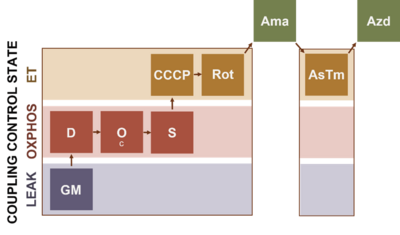Guerrier 2023 MiP2023
| Human white adipose tissue mitochondrial respiration: effect of body composition |
Link: MiP2023 Obergurgl AT
Guerrier Lisa (2023)
Event: MiP2023 Obergurgl AT
Authors: Guerrier Lisa, Malpuech-Brugere C, Bacoeur-Ouzillou O, Cassagnes L, Pezet D, Gagniere J, Richard R, Touron Julianne
Introduction: Adipose tissue (AT), as an endocrine organ, plays an important role in health and diseases, but unlike skeletal muscle, its energy metabolism have been under investigated due to technical limitations. Nevertheless, according to recent studies, mitochondria could play a predominant role in AT disorders and their activity could depend on adiposity level (1-3). This study aims to evaluate mitochondrial activity and metabolism of human visceral and subcutaneous white AT and their relationship with body mass index (BMI) and composition.
Methods: Sixty-two patients undergoing digestive surgery, without chemotherapy, nor parietal infection, have been included in the study with BMI ranging from 15.4 to 51.9 kg·m-2. Their body composition was assessed by computed tomographic (CT) image at third lumbar vertebra (L3). Mitochondrial function was measured in situ in digitonin-permeabilized adipocytes using high resolution respirometry and a substrate/inhibitor titration approach (Figure) (4,5). Protein accumulation of mitochondrial and lipid metabolism key elements was evaluated by Western-blot.
Results and discussion: Results showed a negative correlation between maximal mitochondrial respiration and BMI (p<0.05) as well as with AT surface, regardless of the anatomical location, though, OXPHOS respiration was significantly higher in visceral (2.22±0.15 pmol·sec-1·mg-1) than in the subcutaneous AT (1.79±0.17 pmol·sec-1·mg-1).
Thus, mitochondrial function can be studied with small amount of AT despite its low mitochondrial density and can be discriminated according to AT depot and BMI. Further analyses are required to know whether the observed differences are quantitative and/or qualitative, as well as to identify the mechanisms involved
- Ling Y et al. (2019) Persistent low body weight in humans is associated with higher mitochondrial activity in white adipose tissue. https://doi.org/10.1093/ajcn/nqz144
- Fischer B, Schöttl T, Schempp C, Fromme T, Hauner H, Klingenspor M, Skurk T (2015) Inverse relationship between body mass index and mitochondrial oxidative phosphorylation capacity in human subcutaneous adipocytes. https://doi.org/10.1152/ajpendo.00524.2014
- Wessels B, Honecker J, Schöttl T, Stecher L, Klingenspor M, Hauner H, Skurk T (2019) Adipose Mitochondrial Respiratory Capacity in Obesity is Impaired Independently of Glycemic Status of Tissue Donors. https://doi.org/10.1002/oby.22435
- Kraunsøe R, Boushel R, Neigaard Hansen C, Schjerling P, Qvortrup K, Støckel M, Mikines KJ, Dela F (2010) Mitochondrial respiration in subcutaneous and visceral adipose tissue from patients with morbid obesity. https://doi.org/10.1113/jphysiol.2009.184754
- Sahl RE, Frederikke Høy Helms E, Schmücker M, Flensted-Jensen M, Ingersen A, Morville T, Dela F, Wulff Helge J, Larsen S (2021) Reliability and variation in mitochondrial respiration in human adipose tissue. https://doi.org/10.1080/21623945.2021.1991617
• Keywords: Mitochondrial respiration, white adipose tissue, human
Figures

Ama: antimycine A, AsTm: Ascorbate/TMPD, , Az: azide, CCCP: uncoupler, c: cytochrome c, D: ADP, ET: electron transfer, G: glutamate, M: malate, O: octanoyl carnitine, Rot: rotenone, S: succinate
Affiliations
- Guerrier Lisa1, Malpuech-Brugère C1,2, Bacoeur-Ouzillou O1,3, Cassagnes L3, Pezet D3, Gagnière J3, Richard R1,2,3, Touron J1,2
- Univ Clermont-Auvergne, INRAe, UNH, F-63000 Clermont-Ferrand, France
- CRNH Auvergne, INRAe, UNH F-63000 Clermont-Ferrand, France
- CHU Clermont-Ferrand, F-63000 Clermont-Ferrand, France
- Corresponding author: lisa.guerrier@uca.fr
- Guerrier Lisa1, Malpuech-Brugère C1,2, Bacoeur-Ouzillou O1,3, Cassagnes L3, Pezet D3, Gagnière J3, Richard R1,2,3, Touron J1,2
Labels: MiParea: Respiration
Organism: Human
Tissue;cell: Fat
HRR: Oxygraph-2k Event: E2






